November Vegetable Gardening Checklist from Paula Wolfel
November is a beautiful time in the Austin garden: pests start to ease up or disappear and the heat and humidity are also gone. Gardens are filled with brassicas, leafy greens, and artichokes, while root vegetables are starting to pop out from the soil. There are also still so many flowers and pollinators.
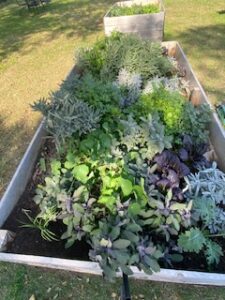
Austin’s Fall Garden has a variety of brassicas, greens, onions and garlic, and root vegetables.
Summer Harvest and Seed Saving
Summer plants that survived the harsh heat and drought of this summer will continue to grow until the first freeze, which the average first frost is November 27th. Keep an eye on the forecast and pick all tomatoes before the first freeze and let them ripen on your kitchen counter, in a sunny window, near bananas, or in a brown paper bag. Eggplants, peppers, cucumbers, okra, and snap beans can also be harvested prematurely. Similarly, snip delicate herbs like basil and either make sauces and freeze them, or dry them and use as dried herbs.
As the summer plants provide their lasts harvest consider saving seeds from open-pollinated annual crops that don’t easily cross-pollinate, like tomatoes, peppers, okra and beans. Shell seeds from pods or the fruit and allow to dry completely. Place in a paper envelope or glass jar and label with variety and date. Store in a cool dry location.
Stockpile Leaves for Mulch or Compost
Stockpile leaves over the next few months to use for spring and summer mulch. Those leaf bags make handy storage containers if you’ve got room to pile them up. Leaves can also be mixed with kitchen waste and added to the compost pile over the winter. Water lightly if the pile is dry to keep the microbial life active.
November Vegetable Garden Checklist
While you’re enjoying the last of the summer blooms, here are some jobs you can do in your November vegetable garden:
FERTILIZE
- Feed vegetable plants with a water-soluble fertilizer every 2-3 weeks while they are actively growing.
WATER
- Water as needed. Daily watering is important for seeds and new transplants during the first two or so weeks—until they put out new leaves. Irrigate plants during dry periods; vegetables that are not watered regularly are more susceptible to pests, diseases, and freeze damage.
- Most vegetables have a growth stage when water is most critical: during head development for broccoli and cauliflower; during flowering and pod enlargement for beans and peas, and during root enlargement for radishes, beets, and carrots. Lettuce and other leafy vegetables do best with a fairly consistent supply of moisture from planting to harvest.
SOIL
- Late fall is one of the best times to amend your soil. Adding organic materials in the fall all time for them to decompose and break down over the winter. I recommend against tilling because tilling disrupts soil structure that you worked so hard all summer to build! Add a thin layer of compost or organic material to the top of your soil and turn the soil lightly with your hands or a garden fork. If you must till, them consider adding compost before tilling that way you are at least mixing it into your soil.
- Always cover your soil with mulch. Mulch helps keep moisture in the soil, suppresses weeds, prevents soil erosion, provides cover for beneficial, predatory insects and spiders.
- Fall is also a good time to get a soil test if you have not done so in a few years. Soil tests will tell you if your soil is ready for the spring and if it is not, it will guide you in what should be added to your soil so you are ready for a big harvest next year. https://soiltesting.tamu.edu/
WHAT TO PLANT
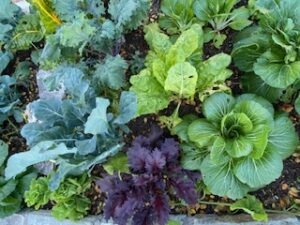
A selection of cool season, mustard, and Asian greens, collards, kale, chard, lettuces and arugula, and Chinese cabbage.
Seeds
- Beets (early November)
- Carrots (early November)
- Fava beans (early November)
- Greens, cool season (all month)
- Radishes (all month)
- Turnips (first half of the month)
Transplants
- Garlic (all month)
- Shallots (all month)
Seeds or Transplants:
- Asian Greens (all month)
- Collards (first half of the month)
- Kale (all month)
- Kohlrabi (early November)
- Lettuce (all month)
- Mustard (first half of the month)
- Spinach (all month)
- Swiss chard (first half)
DISEASES AND PESTS TO LOOK FOR
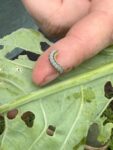
Cross-striped cabbage worm.
- Fall armyworms, cabbage worms, cabbage loopers and cross-striped cabbage worms can be an issue this time of year, especially on brassica crops like broccoli, kale and cauliflower. Cover new plantings with row cover to exclude the moth that lays the eggs or treat plants with a product containing Bacillus thuringiensis (Bt), which comes in either dust or spray form. Bt is deadly when consumed by caterpillars but does not harm other insects. Read the label and follow directions carefully. You can also pick them off with your fingers, and drop them in a cup of soapy water or squash them.
- Aphids are also still around. Lady beetles are the best defense. When they are not present, try spraying the plant with a shot of water or using insecticidal soaps and oils.
- Silverleaf whitefly, grubs, and thrips are also pests that show themselves in the fall and winter garden.
MAINTENANCE
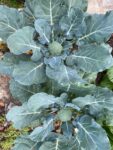
Well-established brassicas can generally withstand freezing weather.
- Monitor weather forecasts for freeze warnings and protect tender vegetables by covering with row cover, sheets, or even a box.
- Tidy up the garden, disconnect hoses, and put away tools before cold weather arrives.
- Pull or cut down weeds before the go to seed.
- If you decide to take a break for the winter season be sure to still cover your soil with mulch!
HARVEST
- Harvest near-ripe tomatoes before the first freeze, and allow them to ripen indoors out of direct sun.
- Enjoy a supply of fresh salad greens by harvesting young leaves of lettuce, kale and spinach. This is when the leaves are small and tender, and have the sweetest flavor. Regular harvesting will stimulate plants to produce more leaves.
Additional Resources
Watch the Vegetable Gardening in Central Texas Webinar
Vegetable Planting Calendar (Español, 繁体中文)
Recommended Vegetable Varieties for Travis County
Plant Rotations, Successions and Intercropping
Sustainable Food Center Farmers Markets
Monthly Gardening Calendar for Austin and Central Texas
About Paula Wolfel
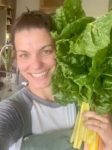 Paula Wolfel joined the Travis County Master Gardener program in 2022, but has been gardening in Austin, Texas since 2017. She grew up in the suburbs of Chicago learning how to garden from both her father—a Sicilian vegetable and fruit tree gardener—and both her grandmothers, and then spent years in Virginia gardening. Paula loves gardening because she finds it to be a grounding force- it gets her out of her head and into the present. She loves the pride that comes with cooking a meal for her family with every ingredient coming from her garden… and then the humility she feels when she loses an entire crop because of Mother Nature. She finds gardening to be wisdom, lessons, best practices passed down generation to generation, season to season and hopes to share that with you.
Paula Wolfel joined the Travis County Master Gardener program in 2022, but has been gardening in Austin, Texas since 2017. She grew up in the suburbs of Chicago learning how to garden from both her father—a Sicilian vegetable and fruit tree gardener—and both her grandmothers, and then spent years in Virginia gardening. Paula loves gardening because she finds it to be a grounding force- it gets her out of her head and into the present. She loves the pride that comes with cooking a meal for her family with every ingredient coming from her garden… and then the humility she feels when she loses an entire crop because of Mother Nature. She finds gardening to be wisdom, lessons, best practices passed down generation to generation, season to season and hopes to share that with you.

